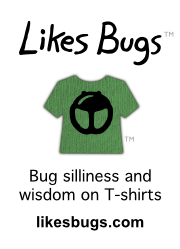On October 19th, at Lake Tawakoni State Park, I photographed two Guatemalan Long-jaws (Tetragnatha guatemalensis) at the center of rather large orb webs. I was thinking, “Aha! The spiders are making orb webs and not just monstrous sheets and tangles.” The next morning I got up early and spent hours watching several locations on Texas’ famous giant web.
I was trying to photograph regular orbweavers (family Araneidae) tearing down and eating their orb webs. Many nocturnal orbweavers do this in the morning. I did catch some of that, but I was disappointed when a female Furrow Spider (Larinioides cornutus) I’d been watching simply retired to her retreat without recycling her web.
Imagine my surprise when I came back to the web an hour and a half later and saw this:
That’s a female Guatemalan Long-jaw spider at the hub of the Furrow Spider’s orb web. This spider had taken over another spider’s web.
I had earlier videotaped an interaction between this same female Furrow Spider and a male Furrow Spider that was courting her from the edge of the web. Had I known what was about to happen, I would have snapped a high resolution image of the female in her web. Instead, the following low resolution still-frames (with enhanced contrast) will have to serve as evidence that indeed a Furrow Spider previously owned this web:
It’s hard to visually compare the webs in the photos because of their different resolutions and because I took them at different angles. The weight of the Furrow Spider also distorts the web, since the Furrow Spider weighed a lot more than the Guatemalan Long-Jaw. Even so, if you scrutinize the webs closely enough, you’ll see many details in common (especially when you look at multiple still frames). One big difference is that there is a prey item wrapped at the hub when the Furrow Spider was present, but it appears to have been removed from the hub when the Guatemalan Long-jaw was present. Either spider could have done that.
(You can click on any of the above images to see them in higher resolution, should you feel the need to scrutinize the webs more closely.)
It’s well documented, at least for some species of orbweavers, that when the food is plentiful, the spider may not bother to take down and eat its web. The main reason for eating the web is to reuse the protein in the next night’s web. There’s little reason to recycle the web if the night’s catch replenished the spider’s supply of protein.
The Guatemalan Long-jaws did make orb webs at night—or at least the females did. But at Lake Tawakoni, the orbs I saw them make were small, generally under eight inches in diameter (I’m guessing). The Furrow Spider webs were typically much bigger, as I often saw them side by side. Now I’m inclined to think that those Guatemalan Long-jaws I was photographing in the big orb webs were actually in other spiders’ webs. In particular, I never saw an adult male Guatemalan Long-jaw ever build an orb web, but I have photos of two males of this species in large orb webs anyway. Curiously, I don’t think I ever saw a Guatemalan Long-jaw in a large orb web at night, when the Furrow Spiders and other orbweavers would re-emerge.
Here are some photos of Guatemalan Long-jawed Spiders that may actually be in webs made by other kinds of orbweavers:
Does anybody know how to reliably distinguish the orb webs of long-jawed orbweavers (family Tetragnathidae) from those of regular orbweavers (family Araneidae)? Not all long-jawed orbweavers remove the hubs from their webs; I don’t think I ever saw a Guatemalan Long-jaw do so, and in my video all of their webs appear to have hubs. I didn’t think to take hi-res photos of the orbs that the Guatemalan Long-jaws were making. I could use them now for comparison.





